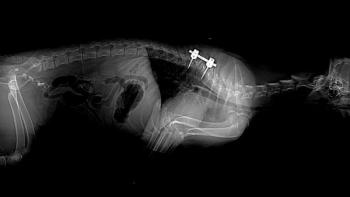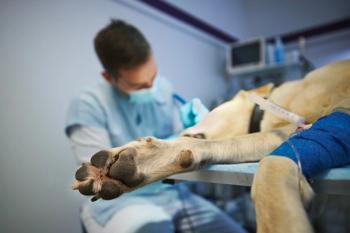
The shakyyyyy......doogggg... (Proceedings)
Tremors in people are classified/described in many different ways: neuroanatomical location, rate, amplitude, rhythmicity, relationship to rest and movement, posture, performance of specific tasks, medical and family history.
Tremors in people are classified/described in many different ways: neuroanatomical location, rate, amplitude, rhythmicity, relationship to rest and movement, posture, performance of specific tasks, medical and family history. Other classification schemes are based on underlying pathological change and etiology.
Currently there is no formal classification scheme in dogs/cats. Veterinary neurologists often use the signalment and history, neurological examination findings, and the conditions under which the tremor is activated to develop list of likely causes.
Description of Tremors or Other "Shakes"
Myoclonus
A sudden, rapid, involuntary muscle movement of short duration caused by muscle contractions and pauses in muscle activity. It may be regular or irregular. Usually involves an entire muscle or groups of muscles. In dogs, myoclonus is commonly associated with distemper encephalomyelitis. Limb or jaw muscles are commonly affected and the myoclonus persists during sleep. It may be seen during the acute phase of infection, but more commonly occurs in the chronic phase. It may persist for years after recovery from other signs of distemper.
Fasciculations
Spontaneous contractions of muscle fibers within a motor unit causing a subtle or fine "rippling" or "twitching" of muscles. Fasciculations arise from ectopic electrical activity of the distal axon. They are most often associated with neuromuscular diseases.
Tremors
These rhythmical oscillatory movements may be focal (just affecting one limb or the head) or generalized. They are only recognized when animals are awake; true tremors abate during sleep.
Intention tremors
These tremors become more obvious as the animal approaches a target with its body or head. They are associated with cerebellar disease.
Action tremor is a tremor that occurs during voluntary contraction of skeletal muscle, and is further classified as postural, kinetic, isometric, or task specific. Kinetic tremor is an oscillation during directed voluntary movement.
Neuroanatomical localization
Tremors are associated with motor unit disease, brain disease (particularly cerebellar disease), diffuse CNS disease, and central myelination disorders
Motor Unit Diseases
Myopathy, junctionopathy or neuropathy may have tremors secondary to weakness. The neuroanatomical localization of neuromuscular disease is made on the basis of the history (weakness with exercise) and finding generalized lower motor neuron deficits and/or generalized weakness.
Cerebellar Diseases
Animals with cerebellar disease typically have inability to judge distance (dysmetria), which usually results in overstepping (hypermetria). An intention tremor and truncal swaying are also common. Vestibular dysfunction can also occur. Pure cerebellar disease does not cause weakness or changes in mentation.
Diffuse Central Nervous System
The most common myelination problems are seen in younger animals with myelin deficiencies.
Specific Diseases or Recognized Syndromes Causing Tremors
Head Tremors/Movement Disorders/Head Bobs
Breeds affected: Boxer, English Bulldog, French Bulldog, American Bulldog, Labrador retriever, Bassett hound, Great Dane, Malamute, Doberman pinscher.
Pathophysiology: This is a clinical sign and/or syndrome of unknown etiology that results in intermittent head tremors. There are no retrospective or prospective publications and much of what is known about the disorder has been passed down from neurologist to neurologist. There have been at least 3 theories as to the origin of the tremors.
1. They may represent a focal seizure discharge.
2. They are a form of dyskinesia or a spontaneous discharge from the basal nuclei, which are involved in patterned motor activity.
3. They may be an abnormality of the stretch mechanism and the proprioceptive pathway of the head (trigeminal nerve). This theory may explain why the head tremors temporarily stop when the animal's attention is diverted i.e. when they are directed to look at you or something else, the neck muscles tense which may release the stretch mechanism that is provoking the tremors.
Description: Episodes of head tremors that last seconds to a few minutes. Affected dogs appear to be fully alert during these episodes. Tremors consist of either up and down (like shaking the head "yes") or back and forth (like shaking the head "no") motions. They seem to start and stop spontaneously, but dogs may be momentarily distracted during the episode by directing their attention to something. Thus far, patients have not developed any other neurological deficits and generalized seizure activity has not been reported.
Diagnosis: Diagnostic evaluations, including MRI and spinal fluid analysis results, are typically normal.
Prognosis: Good as signs are not life-threatening and are intermittent.
Treatment: The response to anticonvulsants is somewhat controversial with some neurologists indicating no response and others indicating that some dogs seem to respond.
Dysmyelination and Hypomyelination
Breeds affected: This disorder is inherited in Springer spaniels and Samoyeds as a sex-linked recessive trait; males are severely affected for life. In chow chows, Weimeraners, Bernese mountain dogs, and Dalmatians, the inheritance is less clear, but both sexes can be affected. In these breeds, clinical signs usually resolve within a year, coincident with further myelination of the nervous system.
Pathophysiology: CNS axons are unmyelinated, thinly myelinated, or abnormally myelinated. The underlying cause is unknown, but is most likely an inherited genetic defect.
Description: Generalized coarse action tremors are noted when the dogs start to walk. The pelvic limbs are often more severely affected resulting in a "rocking horse"-type movement. The amplitude of the tremor is usually greater than that seen with cerebellar disease. Other than a pendular nystagmus, there are no other obvious neurological deficits.
Diagnosis: Clinical signs, CNS histopathology.
Prognosis: Some often improve with age (see breeds affected).
Treatment: No effective therapy
Steroid-Responsive Tremors or Generalized Tremor Syndrome in Dogs
Breeds affected: This disease was initially reported in small breed white dogs (e.g., Maltese, West highland white terriers), and was called "Little White Shaker Disease". Since this disease is also recognized in dogs with other coat colors and in larger breeds, it is now more commonly called "generalized tremor syndrome of dogs" or steroid responsive tremors. Age range varies but many cases are less than 2 years of age.
Pathophysiology: The underlying cause is unknown, but since cases are "steroid responsive", an immune mediated pathogenesis is suspected.
Description: Tremors are noted at rest but are much worse with excitement; they are absent during sleep. Dogs usually have a low amplitude "fine" generalized action tremor. In addition to tremors, some dogs have other clinical signs compatible with brain disease, such as seizures, vestibular and cerebellar signs.
Diagnosis: Normal minimum database. Normal MRI. Normal or mild CSF pleocytosis (mostly mononuclear cells). Serology and PCR for infectious diseases are negative.
Prognosis: Excellent since dramatic improvement is seen with corticosteroid treatment.
Treatment: Corticosteroids
Primary Orthostatic Tremors in Great Danes
Breeds affected: young Great Danes (also reported in Scottish deerhounds)
Pathophysiology: The underlying cause is unknown, but in people orthostatic tremors have been hypothesized to be caused by a supraspinal generator, which may be associated with cerebellar, thalamic or basal nuclei disease.
Description: Progressive generalized tremors are usually noted only when affected dogs are standing, at rest. Tremors increase in amplitude when the dogs try to lie down. Tremors tend to abate when the dogs walk, lay down, lean against objects, or when the dog is lifted off the ground. Facial tremors and difficulty eating have been described. Physical and neurological examinations are normal. When a stethoscope is applied to a tremoring muscle, a sound resembling a distant helicopter rotor can be heard.
Diagnosis: Definitive diagnosis of OT requires documentation of the characteristic tremor pattern, a frequency of 13-18 Hz, during a conscious electromyographic (EMG) examination.
Prognosis: Although insufficient data currently exists to make a definitive statement regarding the long-term prognosis associated with OT in Great Danes, it appears to be a disease that can be chronically managed with medication, although the tremors may increase in severity in some dogs over periods of months to years despite escalations in drug therapy.
Treatment: Clonazepam or gabapentin
Old Dog Hind Limb Tremors
Breeds affected: Any, particularly terriers and larger breeds; often very old dogs.
Pathophysiology: The etiology and pathogenesis are unknown. There are no published studies so it is possible that there may be multiple etiologies. Possible theories include, neuropathy, pain, DJD, neoplasia, and spinal cord diseases like lumbosacral instability.
Description: The tremors are usually a slow onset, mild, and most commonly affecting one or both pelvic limbs. May be most apparent when the dog is standing or sitting/laying at rest. They may disappear with movement.
Diagnosis: Clinical signs.
Prognosis: Signs may be slowly progressive, but do not appear to negatively affect the dog.
Treatment: None known
Metabolic disorders causing tremors
Metabolic disturbances may alter the resting membrane potential of muscle or nerves, and therefore may cause weakness and tremors due to spontaneous depolarization. Examples: electrolyte disturbances (e.g. hypercalcemia, hypocalcemia, hyperkalemia, hypokalemia, hypoglycemia, alkalosis, acidosis), hypoxia, and azotemia.
Toxicities that may cause tremors
Organophosphate, metaldehyde, strychnine, mycotoxins (penitrem-A), ivermectin, theobromine, caffeine, amphetamines, and hexachlorophene, bromethalin, lead, penitrem (a mycotoxin found in molded diary products), macadamia nuts, metaclopramide, fentanyl/droperidol, and diphenhydramine, zolpidem.
Summary: Approach to Patients that Present with Tremors
1. Inquire about potential exposure to toxins. Flea/tick control products? Caffeine? Chocolate? ADD drugs in house? Horses or cattle (ivermectin)? Illicit drugs?
2. Inquire about duration of tremors (how long present) since you may be able to rule out many of above toxins if tremors have been present for many days/weeks.
3. Rule out potential metabolic causes of tremors (hypoglycemia, hypokalemia, hyperkalemia, hypocalcemia) with serum chemistry profile.
4. Try to localize the tremors to neuromuscular junction, cerebellar, or diffuse CNS areas.
5. Description of tremors may allow you to give a specific diagnosis: myoclonus most often associated with distemper; orthostatic tremors in Great Danes; head bobbing/tremors in certain breeds of dogs.
Newsletter
From exam room tips to practice management insights, get trusted veterinary news delivered straight to your inbox—subscribe to dvm360.





